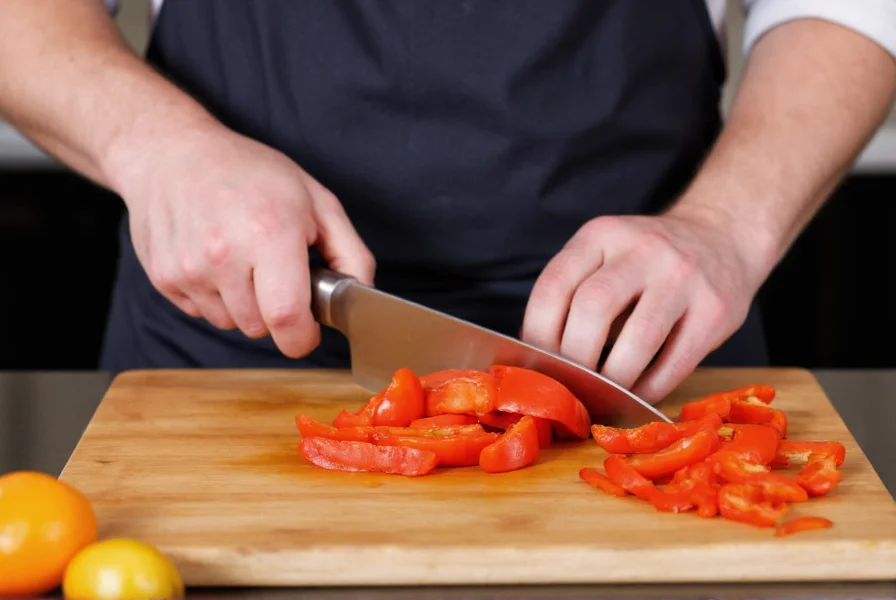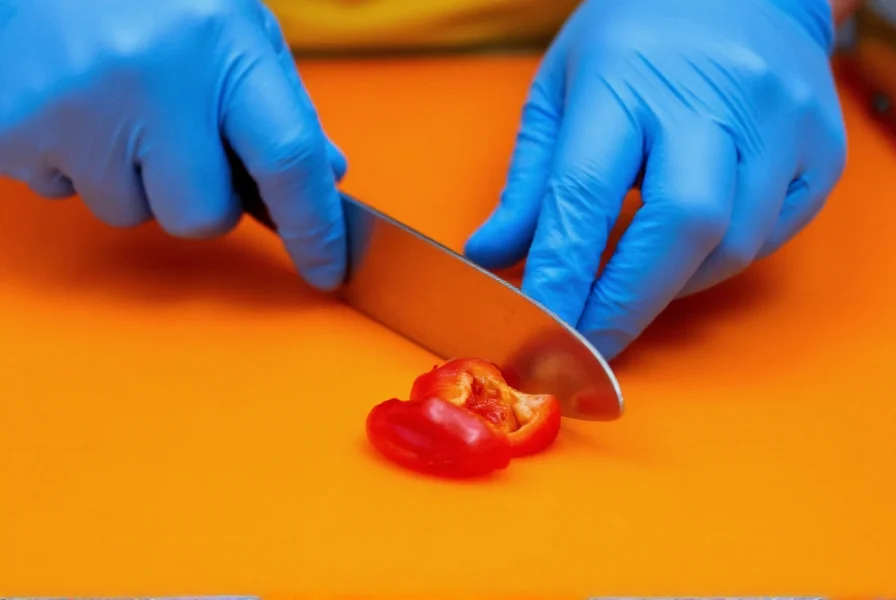Dicing peppers correctly transforms your cooking experience, ensuring even cooking and professional-looking results. Whether you're preparing bell peppers for stir-fry or jalapeños for salsa, mastering this fundamental kitchen skill saves time and reduces food waste. The proper pepper dicing technique creates uniform pieces that cook evenly, enhancing both flavor distribution and visual appeal in your dishes.
Essential Tools for Dicing Peppers
Before learning how to dice peppers, gather these kitchen essentials. The right tools make the process safer and more efficient, especially when handling different pepper varieties.
| Tool | Recommended Type | Why It Matters |
|---|---|---|
| Knife | 8-inch chef's knife | Provides control and precision for clean cuts through pepper flesh |
| Cutting Board | Stable wooden or plastic board | Prevents slipping and protects knife edge |
| Optional | Nitrile gloves | Essential protection when dicing hot peppers like habaneros |
| Optional | Small spoon | Makes seed removal quicker and more thorough |
Step-by-Step Guide: How to Dice Any Pepper

1. Prepare Your Workspace and Pepper
Wash the pepper thoroughly under cold running water. Pat dry with a clean towel. Place your cutting board on a stable, non-slip surface. For hot peppers like jalapeños or habaneros, put on nitrile gloves before handling to prevent skin irritation.
2. Trim the Ends
Place the pepper vertically on your cutting board. Using a sharp chef's knife, carefully slice off the top (stem end) and bottom (blossom end). This creates flat surfaces that help stabilize the pepper for safer cutting.
3. Cut Open the Pepper
Stand the pepper upright on one of the flat ends. Make a vertical slice from top to bottom, cutting through the thickest part of the pepper wall. Open the pepper like a book to expose the interior. This proper technique for dicing bell peppers works equally well for hotter varieties.
4. Remove Seeds and Membranes
Lay the pepper flat on the cutting board with the interior facing up. Use your knife tip or a small spoon to scrape away seeds and white membranes. For milder flavor in dishes, remove all white pith as it contains most of the heat in hot peppers. This step is crucial when learning how to dice peppers without tears or excessive heat.
5. Create the Dice
Position the pepper flat side down. Make vertical slices parallel to the long edge at your desired width (typically 1/4 to 1/2 inch). Rotate the pepper 90 degrees and make horizontal slices. Finally, chop across the strips to create uniform cubes. This method ensures evenly sized pepper pieces that cook consistently.
Special Considerations for Different Pepper Types
Understanding how to dice different peppers properly enhances both safety and cooking results. Each variety presents unique challenges that require slight technique adjustments.
Bell Peppers
These large, thick-walled peppers benefit from the standard dicing technique. Their size makes them ideal for practicing proper pepper dicing technique for beginners. When dicing bell peppers for cooking, maintain consistent thickness to ensure even cooking in stir-fries or fajitas.
Hot Peppers (Jalapeños, Serranos, Habaneros)
Always wear gloves when handling hot peppers. Work in a well-ventilated area and avoid touching your face. For the safest approach to dicing hot peppers, remove seeds and membranes completely to reduce heat. Consider using a dedicated cutting board for hot peppers to prevent cross-contamination with other foods.

Avoiding Common Pepper Dicing Mistakes
Even experienced cooks make errors when dicing peppers. Recognizing these pitfalls helps you perfect your technique:
- Inconsistent sizing: Creates uneven cooking. Focus on maintaining uniform slice thickness throughout the process.
- Skipping the flat surface step: Trimming ends first provides stability and prevents rolling. This safety consideration is essential in any step by step guide to dicing peppers.
- Improper knife grip: Hold the knife handle firmly with your dominant hand while using a "claw grip" with your other hand to guide the pepper.
- Not removing all membranes: White pith contains most of the heat in hot peppers. Thorough removal gives you better control over dish spiciness.
Storing Diced Peppers Properly
Place diced peppers in an airtight container with a slightly damp paper towel to maintain freshness. Store in the refrigerator for up to 5 days. For longer storage, freeze diced peppers on a baking sheet before transferring to freezer bags. This technique for dicing peppers ahead of time saves valuable meal prep time while maintaining quality.
Frequently Asked Questions
What's the best knife for dicing peppers?
An 8-inch chef's knife provides the perfect balance of control and efficiency for dicing peppers. The curved blade allows for smooth rocking motions while maintaining precision. Keep your knife properly sharpened, as a dull blade requires more pressure and increases the risk of slipping.
How do I prevent tears when dicing onions and peppers together?
Cut peppers before onions, as pepper vapors don't cause tearing. When dicing peppers alongside onions, work quickly through the onion portion. Chill onions for 30 minutes before cutting to reduce volatile compounds. Use sharp knives for cleaner cuts that release fewer irritants.
Can I dice peppers in a food processor?
While possible, food processors often create uneven, mushy results when dicing peppers. For most cooking applications requiring diced peppers, the manual technique produces superior texture and consistency. If using a processor, pulse in short bursts and avoid over-processing to maintain proper dice size.
Why do my diced peppers become soggy?
Soggy diced peppers usually result from improper storage or over-handling. Always pat peppers dry before dicing, and store in containers with ventilation or a slightly damp paper towel. Avoid salting diced peppers too far in advance, as salt draws out moisture. For cooking applications, add diced peppers at the appropriate time in your recipe to maintain texture.











 浙公网安备
33010002000092号
浙公网安备
33010002000092号 浙B2-20120091-4
浙B2-20120091-4